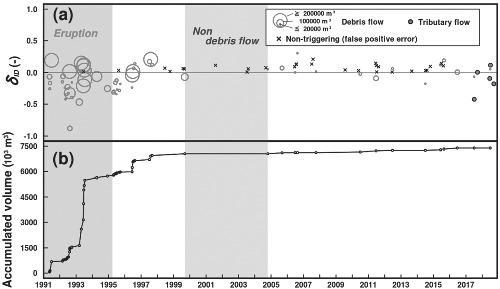当前位置:
X-MOL 学术
›
Earth Surf.Process. Land.
›
论文详情
Our official English website, www.x-mol.net, welcomes your
feedback! (Note: you will need to create a separate account there.)
Multi-decadal changes in the relationships between rainfall characteristics and debris-flow occurrences in response to gully evolution after the 1990–1995 Mount Unzen eruptions
Earth Surface Processes and Landforms ( IF 2.8 ) Pub Date : 2021-05-08 , DOI: 10.1002/esp.5148 Haruka Tsunetaka 1 , Yoshinori Shinohara 2 , Norifumi Hotta 3 , Christopher Gomez 4 , Yuichi Sakai 5
Earth Surface Processes and Landforms ( IF 2.8 ) Pub Date : 2021-05-08 , DOI: 10.1002/esp.5148 Haruka Tsunetaka 1 , Yoshinori Shinohara 2 , Norifumi Hotta 3 , Christopher Gomez 4 , Yuichi Sakai 5
Affiliation

|
Explosive volcanic eruptions can cause long-term landscape change, leading to increased sediment discharge that continues after the cessation of the eruptions. During the period 1990–1995, eruptions of Mount Unzen, Japan, generated large amounts of pyroclastic material, resulting in 57 debris-flow events during 1991–2018. To investigate changes in the relationships between rainfall characteristics and debris-flow occurrence, we conducted the following: geometric analysis of two gullies (i.e., debris-flow initiation zones) using LiDAR (light detection and ranging)-generated 1 m DEMs (digital elevation models); rainfall analysis, based on the relationship between rainfall duration and mean intensity (i.e., considering the intensity–duration, or ID, threshold); and debris-flow monitoring during 2016–2018. Since 1991, rainfall runoff has caused erosion of the supplied pyroclastic material, generating a channel network consisting of incised gullies. With sufficient rainfall, debris flows formed, accompanied by further gully erosion; this resulted in both vertical and lateral adjustments of the cross-sectional geometry. In the two decades since the eruptions ceased, readily mobilized pyroclastic material has become scarce as the gullies have adjusted to local hydrographic conditions. At the same time, the infiltration capacity of the volcanic flank has increased, reducing the capacity for overland flow. As a result, since 2000, rainfall events with intensities above the ID threshold have occurred; however, the lack of sediment supplied by the gullies appears to have hindered the occurrence and development of debris flows. This suggests that debris flows in volcanically perturbed landscapes may occur at lower rainfall thresholds as long as the corresponding upland channels are evolving as a result of intense overland flow. However, as such channels evolve towards equilibrium geometries, the frequency of debris flows decreases in response to the reduction in sediment availability.
中文翻译:

1990-1995 年云仙火山喷发后,降雨特征与泥石流发生之间关系的多年代变化响应于沟壑演变
火山爆发会导致长期的景观变化,导致火山喷发停止后沉积物排放增加。1990-1995 年期间,日本云仙山的喷发产生了大量的火山碎屑物质,导致 1991-2018 年期间发生了 57 次泥石流事件。为了研究降雨特征与泥石流发生之间关系的变化,我们进行了以下工作:使用 LiDAR(光探测和测距)生成的 1 m DEM(数字高程)对两个沟壑(即泥石流起始区)进行几何分析楷模); 降雨分析,基于降雨持续时间和平均强度之间的关系(即,考虑强度-持续时间,或ID, 临界点); 2016-2018 年期间的泥石流监测。自 1991 年以来,降雨径流导致所供应的火山碎屑材料受到侵蚀,形成了由切开的沟壑组成的河道网络。雨量充沛,泥石流形成,沟壑进一步侵蚀;这导致横截面几何形状的垂直和横向调整。在火山喷发停止后的 20 年里,随着冲沟适应当地的水文条件,易于移动的火山碎屑材料变得稀缺。同时,火山侧翼的入渗能力增加,降低了地表径流的能力。因此,自 2000 年以来,强度高于ID阈值已发生;然而,由于沟壑缺乏沉积物,似乎阻碍了泥石流的发生和发展。这表明,只要相应的高地通道由于强烈的地表流动而演变,火山扰动景观中的泥石流可能会在较低的降雨阈值下发生。然而,随着这些通道朝着平衡几何形状演变,泥石流的频率随着沉积物可用性的减少而降低。
更新日期:2021-05-08
中文翻译:

1990-1995 年云仙火山喷发后,降雨特征与泥石流发生之间关系的多年代变化响应于沟壑演变
火山爆发会导致长期的景观变化,导致火山喷发停止后沉积物排放增加。1990-1995 年期间,日本云仙山的喷发产生了大量的火山碎屑物质,导致 1991-2018 年期间发生了 57 次泥石流事件。为了研究降雨特征与泥石流发生之间关系的变化,我们进行了以下工作:使用 LiDAR(光探测和测距)生成的 1 m DEM(数字高程)对两个沟壑(即泥石流起始区)进行几何分析楷模); 降雨分析,基于降雨持续时间和平均强度之间的关系(即,考虑强度-持续时间,或ID, 临界点); 2016-2018 年期间的泥石流监测。自 1991 年以来,降雨径流导致所供应的火山碎屑材料受到侵蚀,形成了由切开的沟壑组成的河道网络。雨量充沛,泥石流形成,沟壑进一步侵蚀;这导致横截面几何形状的垂直和横向调整。在火山喷发停止后的 20 年里,随着冲沟适应当地的水文条件,易于移动的火山碎屑材料变得稀缺。同时,火山侧翼的入渗能力增加,降低了地表径流的能力。因此,自 2000 年以来,强度高于ID阈值已发生;然而,由于沟壑缺乏沉积物,似乎阻碍了泥石流的发生和发展。这表明,只要相应的高地通道由于强烈的地表流动而演变,火山扰动景观中的泥石流可能会在较低的降雨阈值下发生。然而,随着这些通道朝着平衡几何形状演变,泥石流的频率随着沉积物可用性的减少而降低。











































 京公网安备 11010802027423号
京公网安备 11010802027423号